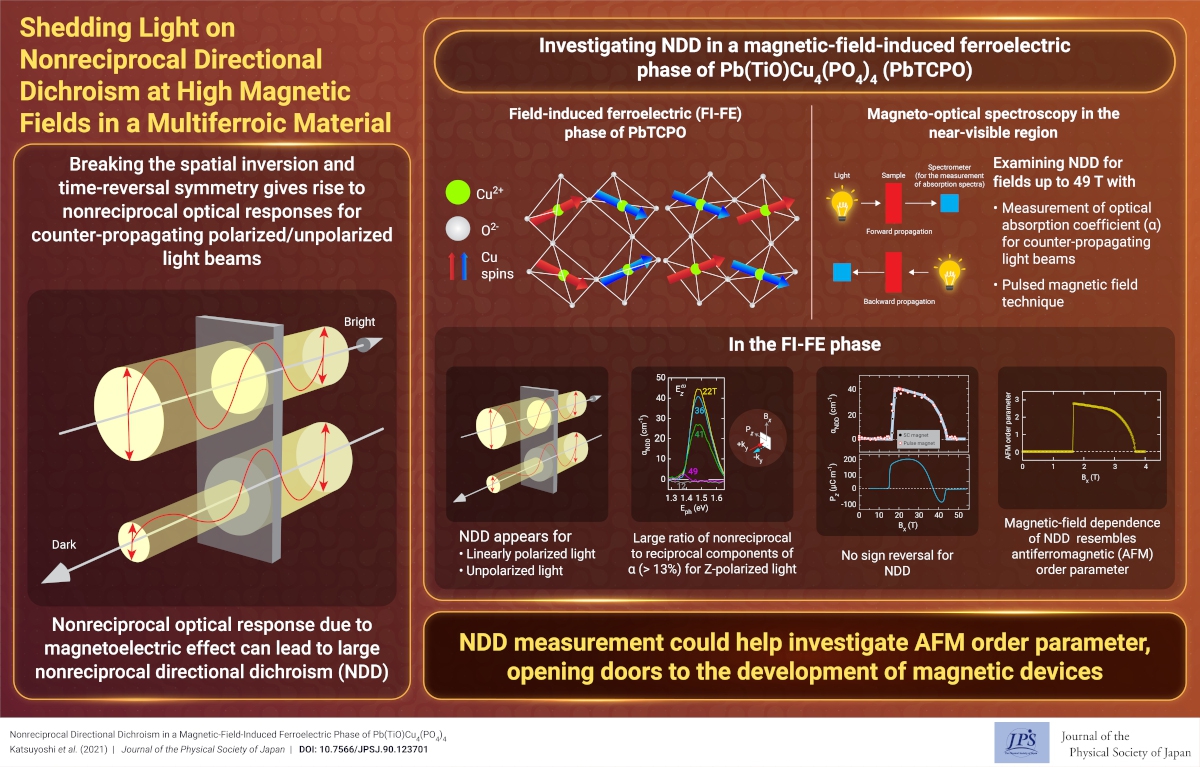Shedding Light on Nonreciprocal Directional Dichroism at High Magnetic Fields in a Multiferroic Material
© The Physical Society of Japan
This article is on
Nonreciprocal Directional Dichroism in a Magnetic-Field-Induced Ferroelectric Phase of Pb(TiO)Cu4(PO4)4
(JPSJ Editors' Choice)
J. Phys. Soc. Jpn. 90, 123701 (2021).
Large optical nonreciprocal directional dichroism, coupled with an antiferromagnetic order parameter, is observed in a high magnetic field via magneto-optical spectroscopy combined with a pulse magnet technique.

When a light beam propagates in a crystal that is asymmetric with respect to both space inversion and time reversal, absorption coefficients between two-counter propagating light beams can be different. This nonreciprocal optical phenomenon is called directional dichroism, which has been intensively studied on the so-called multiferroic materials with broken space-inversion and time-reversal symmetries, in broad wavelength regions ranging from microwave, terahertz, visible, to x-ray. The directional dichroism can appear not only in ferromagnets but also in antiferromagnets when the symmetry requirement is fulfilled. Therefore, the directional dichroism can be employed as a unique working principle of magneto-optical devices based on antiferromagnets and as a useful probe of antiferromagnets. However, the magnitude of previously reported directional dichroism in near-infrared-to-visible (NIR-VIS) region is small, typically about 1% or less in the nonreciprocal to reciprocal components, except for some specific materials. Few reports on antiferromagnets make use of directional dichroism.
In this study, the authors investigated the directional dichroism of a multiferroic material Pb(TiO)Cu4(PO4)4 in high magnetic fields up to 49 tesla via magneto-optical spectroscopy in the NIR-VIS range combined with a pulse magnet technique. Measuring the optical absorption coefficient for counter-propagating light beams, directional dichroism signals were successfully observed in a magnetic-field-induced phase (16 to 45 tesla at a temperature of 2 K). The relative magnitude of the observed signals is significantly large, exceeding 13% at a photon energy of approximately 1.4 eV. Moreover, the magnetic-field dependence of the directional dichroism signals resembles that of a theoretically calculated antiferromagnetic order parameter of the field-induced phase. This strongly suggests that the nonreciprocal directional dichroism (NDD) in the field-induced phase originates from the antiferromagnetic order parameter.
In general, probing an antiferromagnetic order parameter is considerably difficult compared to probing a ferromagnetic order parameter, namely, macroscopic magnetization. There are few experimental probes of an antiferromagnetic order parameter in a high magnetic field regime which is hard to access by typical superconducting magnets. Therefore, the present work not only demonstrates a large NDD but also suggests that the measurement of NDD with a pulse magnet technique provides a unique way of investigating an antiferromagnetic order parameter in a high-field regime.
(Witten by K. Kimura on behalf of all authors)
Nonreciprocal Directional Dichroism in a Magnetic-Field-Induced Ferroelectric Phase of Pb(TiO)Cu4(PO4)4
(JPSJ Editors' Choice)
J. Phys. Soc. Jpn. 90, 123701 (2021).
Share this topic
Fields
Related Articles
-
Antiferromagnetism Induces Dissipationless Transverse Conductivity
Electronic transport in condensed matter
Magnetic properties in condensed matter
Electronic structure and electrical properties of surfaces and nanostructures
2024-7-24
An investigation using high-quality NbMnP crystals demonstrates that the anomalous Hall conductivity arising from antiferromagnetism is dissipationless, as expected from the intrinsic mechanism.
-
d2 Trimer and d3 Tetramer in a Pyrochlore Lattice
Dielectric, optical, and other properties in condensed matter
Electron states in condensed matter
2024-7-11
Based on the charge disproportionation of V3+ and V2+, the V3+(d2) trimers and V2+(d3) tetramers in the vanadium pyrochlore lattice of AlV2O4 are described by the orbitally-induced Peierls mechanism.
-
Structural Rotation and Falsely Chiral Antiferromagnetism: A New Combination Generating Ferrotoroidic State
Magnetic properties in condensed matter
Dielectric, optical, and other properties in condensed matter
2024-7-4
The ferrotoroidic state, an exotic state of matter with broken space inversion and time-reversal symmetries, was achieved by combining structural rotation and falsely chiral antiferromagnetism in PbMn2Ni6Te3O18.
-
Understanding Electronic Ordering and Cross Correlations with Multipole Representation
Magnetic properties in condensed matter
2024-6-12
This study reviews the recent advancements in research of multipole representations for understanding electronic orderings and cross-correlations in materials and presents future research directions.
-
Microscopic Exploration of Electronic States in Nickelate Superconductors
Magnetic properties in condensed matter
Superconductivity
2024-5-31
The multilayered nickelates, La3Ni2O7 and La4Ni3O10 , were investigated using nuclear magnetic resonance (NMR) at ambient pressure. Metallic electronic states under the density wave order were observed microscopically for both compounds.
